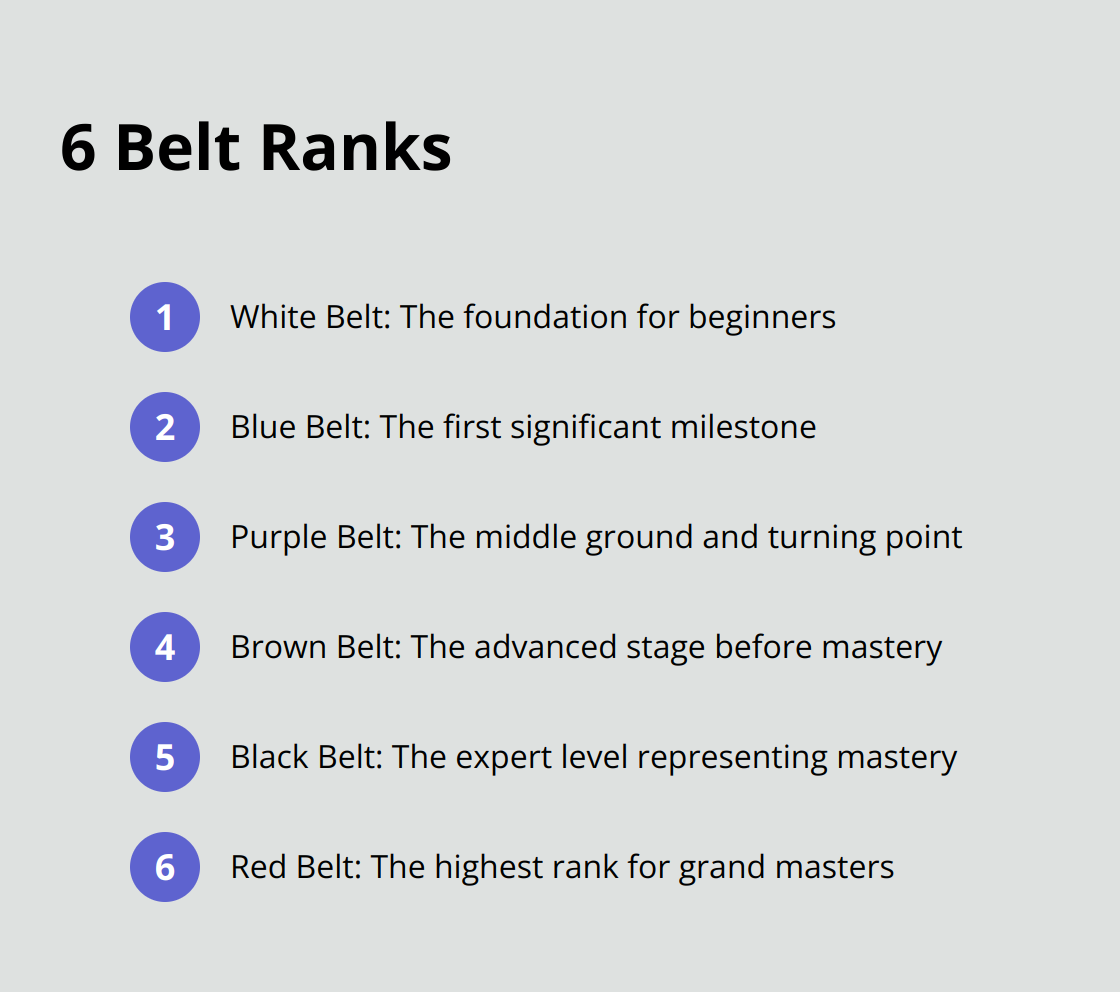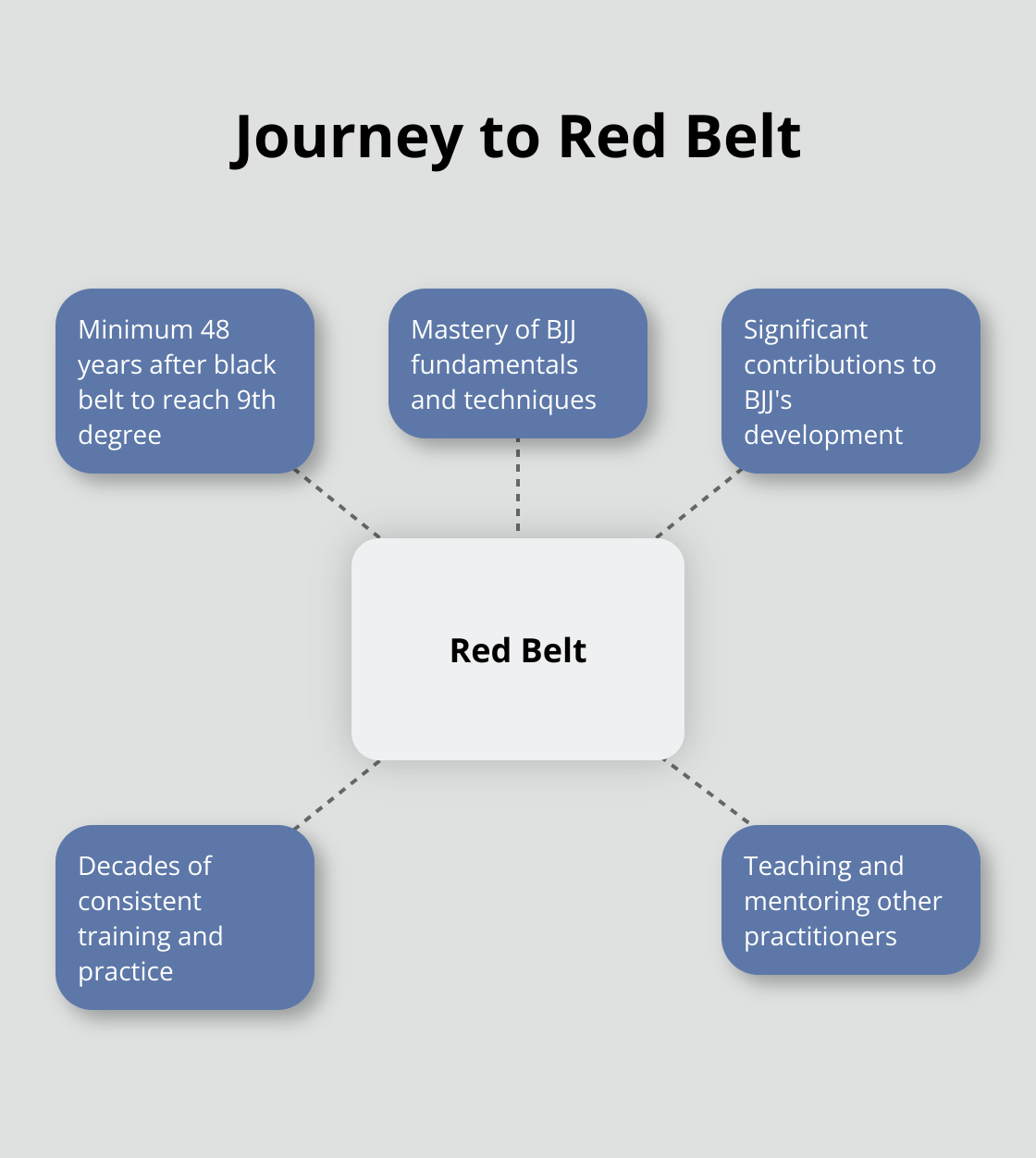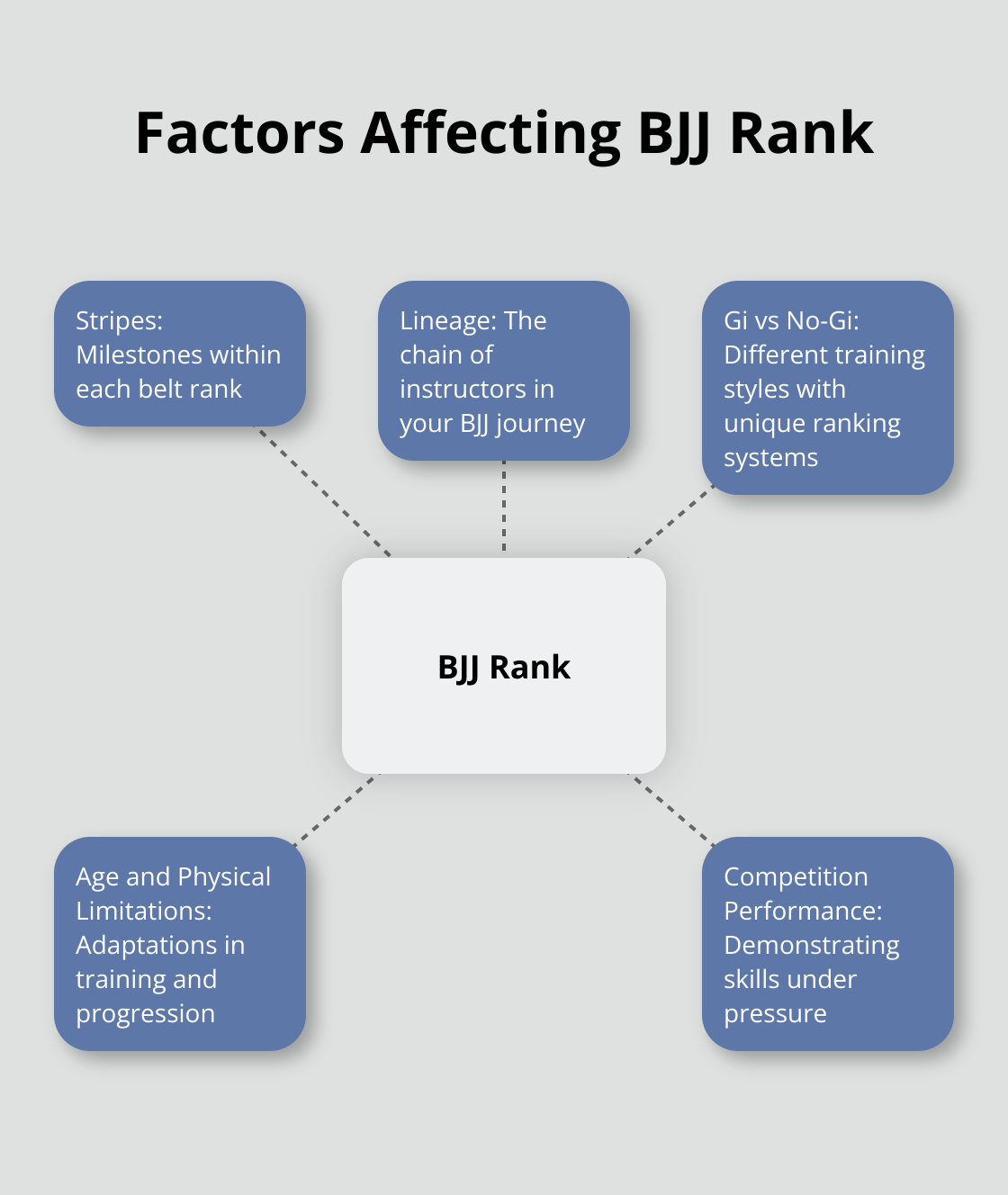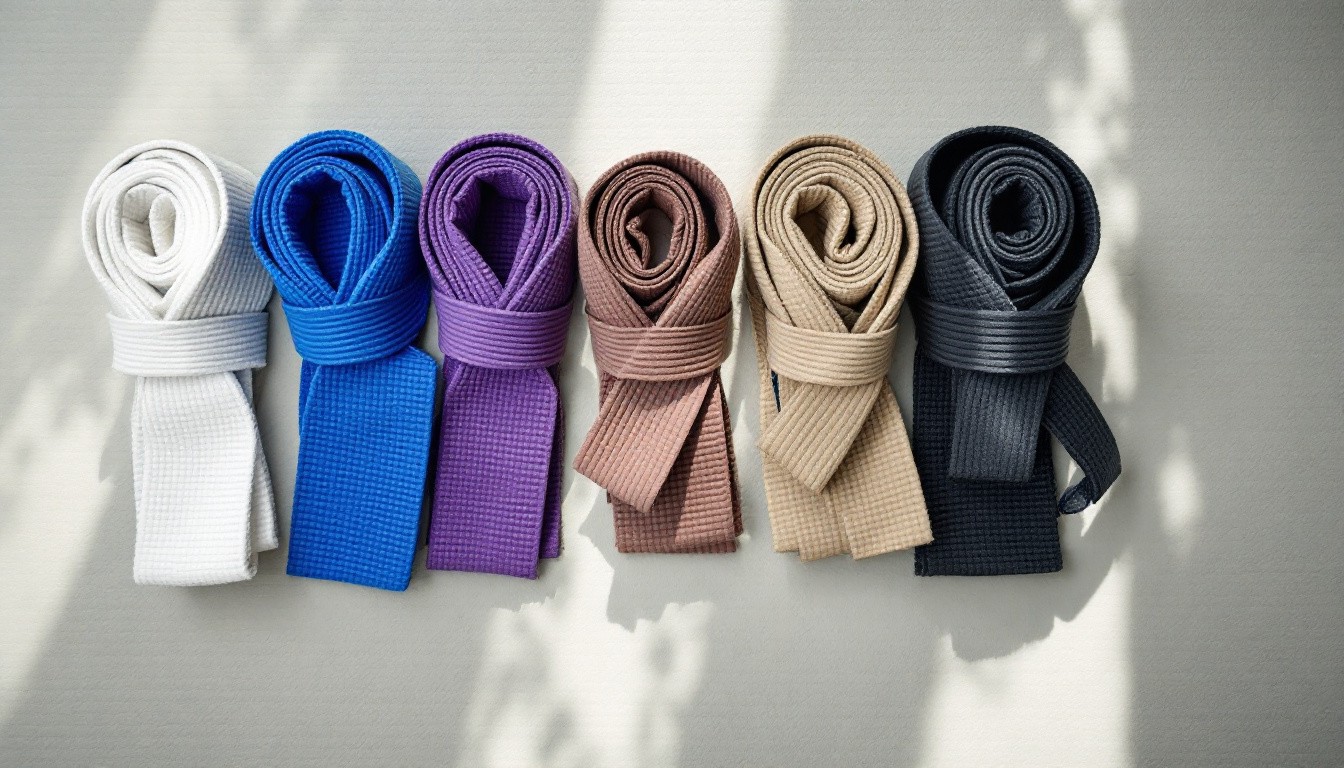At Jiu jitsu, we believe understanding the traditional ranking system is key to every practitioner’s journey. The Jiu Jitsu belt order represents more than just colors; it’s a roadmap of progress and skill development.
From white to black and beyond, each belt signifies a milestone in a student’s growth. This post will explore the intricacies of BJJ rankings, including time requirements, skill expectations, and additional factors that shape a practitioner’s path.
The BJJ Belt Journey: From White to Red
White Belt: The Foundation
Brazilian Jiu-Jitsu (BJJ) uses a belt system to mark a practitioner’s progress. Every BJJ journey begins with the white belt. This rank is held by any practitioner new to the art and has no prerequisite. White belts focus on survival skills, basic positions, and fundamental techniques.
Blue Belt: The First Milestone
Earning a blue belt is a significant achievement. Blue belts have a solid grasp of basic techniques and can execute them effectively. They start to develop their own style and preferences in rolling.
Purple Belt: The Turning Point
Purple belt is often considered the middle ground of BJJ. Practitioners at this level have a deep understanding of techniques and strategies. They can often hold their own against higher belts and start to develop their own “game.”
Brown Belt: The Advanced Stage
Brown belts are on the cusp of mastery. These practitioners have a comprehensive understanding of BJJ and can often teach lower belts effectively. They refine their techniques and develop more advanced strategies.
Black Belt: The Expert Level
The coveted black belt represents mastery of BJJ fundamentals. Black belts have a deep understanding of the art and are expected to contribute to its growth by teaching and mentoring others.
Red Belt: The Grand Master
The red belt is the highest rank in BJJ, reserved for those who have dedicated their lives to the art. It’s extremely rare, typically awarded after decades of practice and significant contributions to BJJ’s development.
At Souza Grappling Co., we emphasize that belts are markers of progress, not the ultimate goal. The true value lies in the skills, discipline, and personal growth gained along the way. Our expert trainers guide students through each stage, ensuring a solid foundation for advancement.

As practitioners progress through these ranks, they often find that the journey becomes more about personal growth than belt color. This shift in perspective leads us to explore the time and requirements for belt progression in the next section.
How Long Does It Take to Advance in BJJ?
Time Investment for Belt Progression
Advancing through the Brazilian Jiu-Jitsu (BJJ) belt system requires dedication, consistency, and skill development. The time spent at each belt level varies significantly. In total, reaching the 9th degree black belt (or Red Belt) in BJJ will take a minimum of 48 years after being granted a black belt. However, these timeframes are not set in stone. Some individuals progress faster, while others take longer. The International Brazilian Jiu-Jitsu Federation (IBJJF) sets minimum time requirements for each belt level, but many schools choose to extend these periods to ensure thorough skill development.

Skill Requirements for Advancement
Advancement in BJJ does not solely depend on time spent training. Instructors assess a range of skills and attributes when considering promotions. These include technical proficiency, tactical understanding, physical conditioning, and mental fortitude. Expert trainers evaluate students’ progress in areas such as positional control, submission execution, defensive capabilities, and overall mat awareness.
The Impact of Competition on Promotions
Competition performance often plays a significant role in belt promotions (although it is not mandatory). Competing allows practitioners to test their skills against peers from other schools and demonstrates their ability to apply techniques under pressure. Many instructors view competition success as a strong indicator of readiness for advancement. However, it’s important to note that not all practitioners choose to compete, and this should not necessarily hinder their progression.
Consistency and Dedication: The Keys to Progress
Consistent training is essential for advancement in BJJ. Regular attendance, active participation in classes, and dedication to improving outside of formal training sessions all contribute to faster progress. Students should maintain a consistent training schedule and supplement their mat time with strength and conditioning work, flexibility training, and studying BJJ instructional content.
Individual Journey and Progress
Advancing through the BJJ belt system is a personal journey that varies for each practitioner. While time spent training is important, the quality of that time and the skills developed truly matter. Students should focus on consistent improvement and embrace the challenges of each belt level. This approach will help them progress steadily and enjoy the rewards of their hard work on the mats.
The next chapter will explore additional factors that influence a practitioner’s rank beyond the traditional belt system.
What Else Affects Your BJJ Rank?
Stripes: Milestones Within Ranks
Stripes on belts mark intermediate progress within each rank. Practitioners can earn up to four stripes before advancing to the next belt color. These stripes indicate consistent training, skill improvement, and readiness for the next rank. Many schools use stripes to motivate students and provide tangible goals between major promotions.
Lineage: Your BJJ Family Tree
Lineage in BJJ refers to the chain of instructors from whom a practitioner has learned. The roots of the sport of Jiu-Jitsu can be traced back to the first generation of fighters of the Gracie Family. A strong lineage can add credibility to a rank and open doors within the BJJ community. However, lineage alone does not determine skill level. Many excellent practitioners come from lesser-known lineages.
Gi vs No-Gi: Different Paths, Same Goal
The ranking systems for Gi and No-Gi BJJ have some differences. Traditional BJJ with a Gi uses the colored belt system, while No-Gi often relies on rash guard colors or a simplified ranking structure. Some schools have developed their own No-Gi ranking system. Despite these differences, the skills and principles remain largely the same. Many practitioners train in both Gi and No-Gi to develop a well-rounded skill set.
Age and Physical Limitations: Adapting the Journey
BJJ accommodates practitioners of all ages and physical conditions. Many schools offer modified programs for older students or those with physical limitations. These adaptations might include longer time between promotions, modified techniques, or alternative ranking systems. The focus shifts to personal growth and technique refinement rather than comparison to younger or more physically capable practitioners.
Competition Performance: Proving Ground
Competition results often influence belt promotions (although not mandatory). Competing allows practitioners to test their skills against peers from other schools and demonstrates their ability to apply techniques under pressure. Many instructors view competition success as a strong indicator of readiness for advancement. However, not all practitioners choose to compete, and this should not necessarily hinder their progression.

Final Thoughts
The Brazilian Jiu-Jitsu ranking system provides a structured framework for practitioners to track their progress. We at Souza Grappling Co. emphasize continuous learning and improvement over the pursuit of belt colors. Our expert trainers help students develop techniques, strategies, and mental fortitude, regardless of their current rank in the Jiu Jitsu belt order.
The BJJ ranking system encourages practitioners to set goals, overcome challenges, and celebrate achievements. Students should approach each training session with a growth mindset, focusing on learning and improvement rather than solely on advancement. This perspective allows practitioners to enjoy the journey, appreciate the nuances of the art, and develop a deeper understanding of BJJ principles.
For those who want to start their BJJ journey or improve their skills, Souza Grappling Co. offers a supportive and dynamic environment. Our facility provides classes for all skill levels (from white to black belt), fostering a community where practitioners can thrive. The true value of BJJ lies in the skills you develop, the friendships you forge, and the personal growth you experience along the way.




